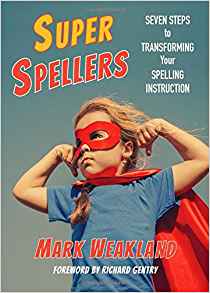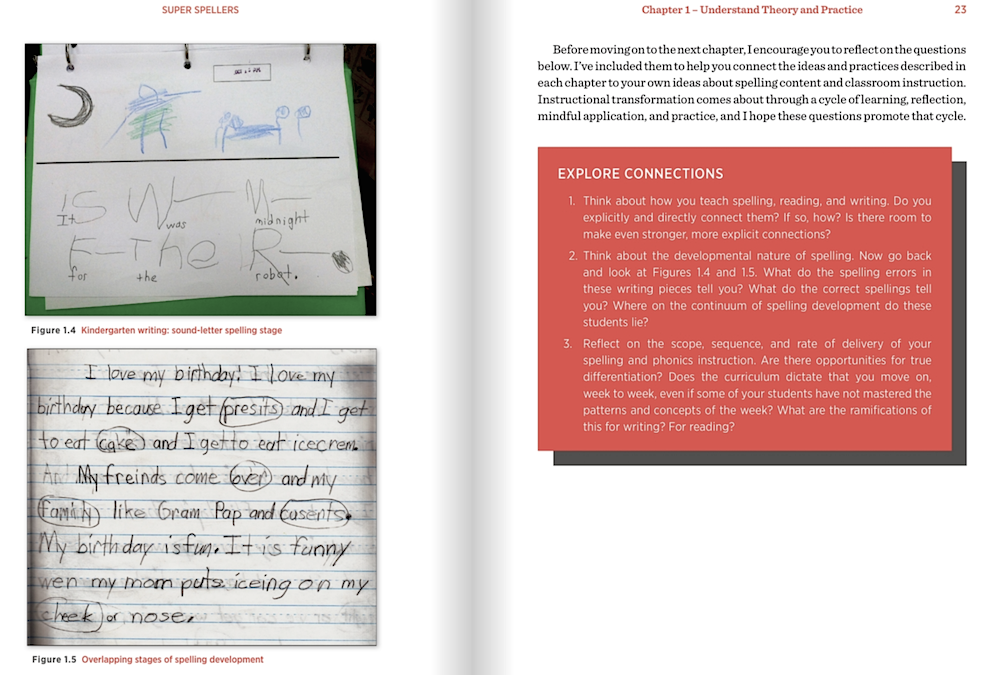7 Steps to Transforming Your Spelling Instruction
Super Spellers: Seven Steps to Transforming Your Spelling Instruction
By Mark Weakland
(Stenhouse, 2017 – Learn more)

Spelling in the upper elementary classroom can consist of a reading program with a literacy Common Core curriculum or can be a stand-alone program offering various lists to differentiate to the diverse learning levels.
In Super Spellers: Seven Steps to Transforming Your Spelling Instruction, Mark Weakland offers a “transformative path” moving away from the memorizing 20 words weekly to a more developmental approach that provides students with strategies and tools to becoming proficient spellers. The book aims at grades K-5 but offers plenty of support for spelling-conscious teachers in grade six and beyond.
The Spelling > Reading connection
Chapter one provides an overview of the theory and practice of spelling and the direct relationship that good spelling has with skillful reading.

Artfully teaching spelling has to be more than a quick presentation of the weekly spelling list, followed up with worksheets and a test. In order to truly learn to spell for more than an end-of-week assessment, students should be given opportunities to work with the words and be immersed in some rich discussions to help create metacognitive pathways to true learning.
Weakland is clear that “poor spellers are poor readers” and backs up his theory with research, stating that “reading is a complex interaction between a number of brain ‘processors’; phonological, orthographic, sound-symbol, and context and meaning.” (page 11)
Developing a year-long plan for spelling instruction
Chapters two through six delve into assessing spelling, considering the scope, sequence, and building of word lists, and strategies for teaching. At the beginning of each school year, an assessment is given, commonly known as a spelling inventory, to gain data that gives a “big picture” of the student as a speller. This inventory needs to be used in conjunction with the students’ writing samples in order to “gain a clearer picture of a child’s specific stage of reading and writing development.” (page 17) Scope and sequence is a must for keeping track of instruction, tracking student progress, and using the data to modify instruction as needed.
Weakland suggests creating “Master Spelling Lists.” The best lists “are developmentally appropriate, not too broad in the concepts they teach, varied in their levels of word difficulty, designed for differentiation, inclusive of words often used in writing, and flexible enough to be used with a variety of instructional activities.” (page 58)
Strategies for instruction include teaching what a syllable is and introducing the seven syllable types. A resource chart is provided offering syllable type, explanation, examples, and exceptions. The idea of syllable types is further explained, offering more reference charts that include open and closed as well as multisyllabic words.
Teaching activities in chapter six include traditional word sorts, sentence dictation, and word ladders. A chart provides nine activities with descriptions, configuration, materials, and grade level.
What I found especially interesting was the “Practice Test with Instant Error Correction.” This is actually an activity and is different from the traditional “pre-test” where students switch papers with a peer as a means to figure out what words the student will focus on before the weekly test. Instead, the teacher gives the word, the students write the word, and then the correct spelling is given before moving on to the next.
It’s simple and elegant. As Weakland writes, “Numerous studies and reviews show that to be an effective instructional tool, feedback must be specific, immediate, goal-directed, and free of competition (Hattie and Timperley 2007, Deci 2014, Samuels and Wu 2003). He is very clear about not allowing students to correct each other’s tests.
Here’s your reason to read a book about spelling
The final chapter discusses building opportunities to connect spelling to reading and writing, including fun activities like scavenger hunts. Weakland urges teachers to create many opportunities to engage with words – reading and writing widely provides students with exponential opportunities to learn commonly used words and more complex ones. Writing turns spelling from abstraction into action and gives it full meaning.
Super Spellers offers ways to abandon ineffective spelling instruction and transform our practice into something that will help students meaningfully expand their word knowledge. In doing so, students will use this knowledge to become better readers and writers and thinkers. If you’re looking for a compelling reason to read a book about spelling, could there be a better one?
Kathleen Palmieri is a fifth grade teacher in upstate New York. With a passion for literacy and learning in the classroom, she participates in various writing workshops and curriculum writing endeavors. As a lifelong learner, she is an avid reader and researcher of educational practices and techniques. Collaborating with colleagues and globally on Twitter @Kathie042500 is an ongoing practice.





































